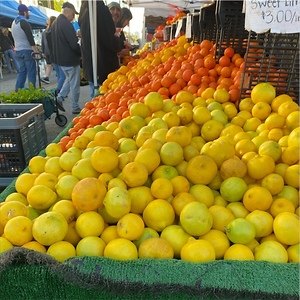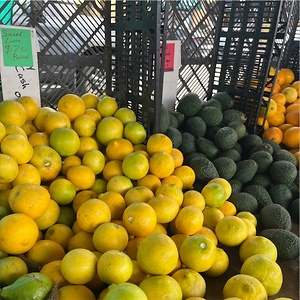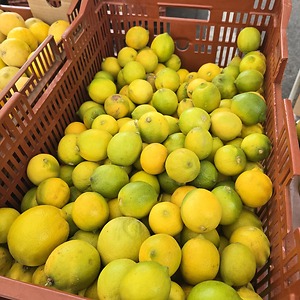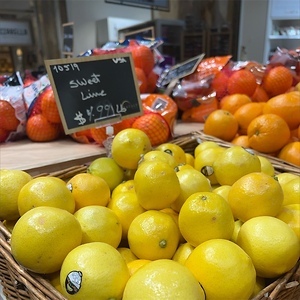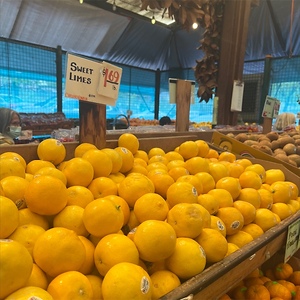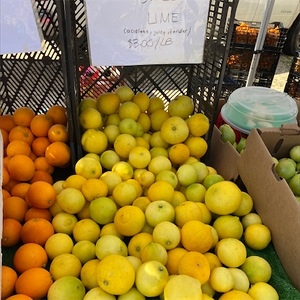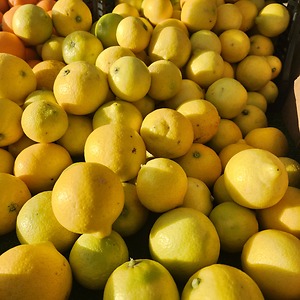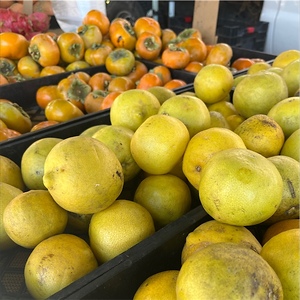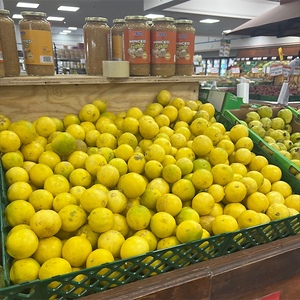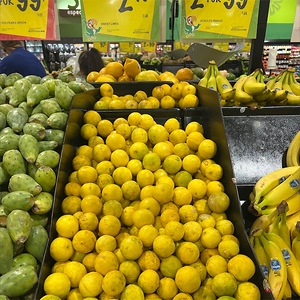

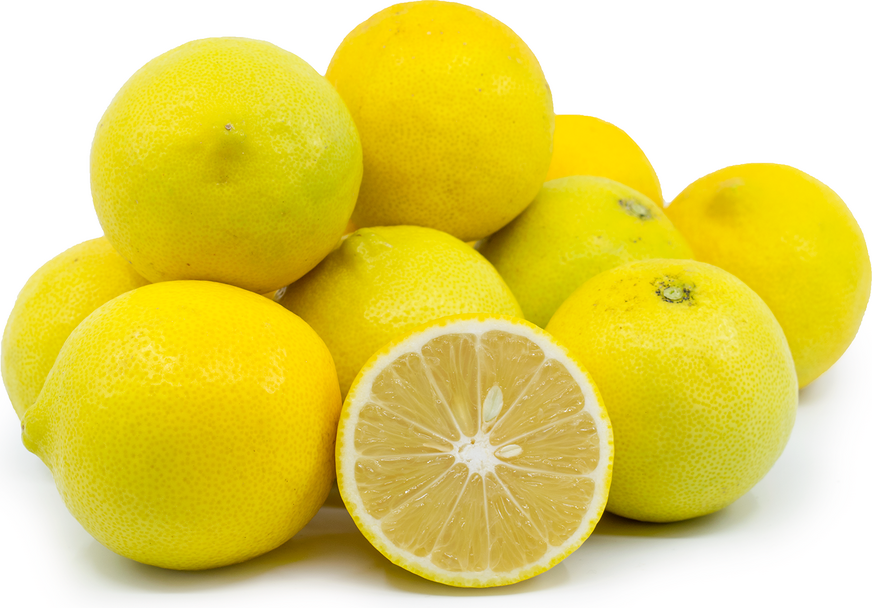
Sweet Limes (Lima Dulce)
Estimated Inventory, lb : 0
Description/Taste
Sweet limes are small in size, averaging 5 to 8 centimeters in diameter, and have a round, elliptic, or oblate shape with a flattened, curved nature. There are several varieties of Sweet limes varying in size, shape, and coloring, and some types may feature a low and flat papilla, also known as a nipple, on the non-stem end. Other varieties may be faintly ribbed, and in general, the fruit’s skin is thin, smooth, taut, and easy to peel. The skin, also known as the rind, ripens from green to shades of golden yellow and is covered in visible oil glands flush with the surface. Underneath the rind, 9 to 10 segments of flesh are divided into sections by thin, white membranes. The pale yellow flesh is soft, tender, aqueous, and succulent, and the fruits contain anywhere from 1 to 5 cream-colored seeds. The core is closed and small, allowing for ample amounts of flesh. Sweet limes release a fragrant, tropical, floral, and pine-like aroma when ripe. Select fruits that have turned mostly golden yellow for the best flavor. A yellow-green coloring may indicate that the fruits have not reached their sweetest. Sweet limes are edible raw and have a mild, sweet, sugary, and floral taste. The fruits lack the acidity and bitterness often associated with limes, creating a more one-note taste of honeyed flavors.
Seasons/Availability
Sweet limes are generally available from July to August and then again from November through March. The availability and fruiting times will vary depending on the climate and hemisphere. In the species’ native regions of India, it is considered a summer monsoon fruit.
Current Facts
Sweet limes, botanically classified as Citrus limettioides, are hybrid fruits belonging to the Rutaceae family. The name Sweet lime is a general category used for several varieties of fruits that showcase sweet, low-acid, and edible flesh. Many types of Sweet limes are grown worldwide, and each variety may vary slightly in size, coloring, shape, and productivity. Throughout markets, Sweet limes are known as Indian Sweet limes, Palestine Sweet limes, and Persian Sweet limes, and popular varieties include Columbia, Soh Synteng, Mitah Chikna, Mithotra, Soh Jew, and NRCC Sweet lime. Sweet limes are also known as Lima Dulce in Central and South America, Mitha Limbu, Mitha Nebu, or Mitha Nimbu in India, Limu Shirin in Iran, Succari or Limun Helou in Egypt, Laymun-helo in Palestine and Syria, Limettier Doux in France, and Tanaka. The species has been growing wild and cultivated for centuries, and the fruits are primarily consumed fresh in culinary preparations and beverages. Sweet limes can also be incorporated into cooked dishes and are a popular ingredient in Indian, Middle Eastern, and Latin American cooking. It is worth noting that Sweet limes are distinct from sweet lemons. Though they share a similar golden yellow hue when ripe, sweet lemons are a completely separate species, Citrus limetta. Both Sweet limes and sweet lemons are native to India. Sweet limes are said to be more concentrated in Uttaranchal, Maharashtra, Himachal Pradesh, and other parts of Northeastern India, while sweet lemons are mainly grown and sold in Meghalaya.
Nutritional Value
Sweet limes are a source of vitamin C to boost the immune system, fiber to regulate the digestive tract, potassium to balance fluid levels within the body, calcium to build strong bones and teeth, phosphorus to produce tissues, and iron to develop the protein hemoglobin for oxygen transport through the bloodstream. The variety has not been extensively studied for nutritional properties beyond these claims, but the species has been noted for its role in Ayurvedic medicine. Sweet limes are believed to be a cooling ingredient that can help lower fevers and soothe upset stomachs. In the Middle East and South America, Sweet limes are used as a preventive treatment for the flu and colds.
Applications
Sweet limes have a mild and sweet taste suited for fresh and cooked preparations. The fruits lack the bright acidity typically found in other commercial limes, and in some regions of Asia and South America, the fruits are peeled and eaten fresh as a snack. Sweet limes can also be rolled to soften the juice inside, pierced with a knife, and then squeezed to release the juice from the hole in the fruit. Consumers squeeze the juice directly into their mouths as an on-the-go drink. Sweet limes can also be sliced and served as an edible garnish alongside appetizers, main dishes, and desserts, but it is important to note that only the flesh is eaten. The peel is not consumed. The fruits can be juiced and added to sauces, dressings, and marinades, or simmered into jams and jellies. Sweet limes are also candied as a sugary treat and are incorporated into chutneys, salsas, and pickles. In addition to fresh preparations, Sweet limes are blended into cordials, fruit juices, cocktails, sparkling water, limeade, and mocktails. The variety is also mixed into desserts such as cakes, pies, cookies, puddings, custards, sorbets, and ice cream. Sweet limes pair well with fruits such as pomegranates, apples, bananas, kiwis, and pineapples, beets, ginger, bell peppers, lettuce, cucumbers, bean sprouts, and meats such as poultry, beef, pork, and fish. Whole, unwashed Sweet limes will keep for 2 to 4 weeks when stored in the refrigerator’s crisper drawer. At room temperature, the fruits will keep for a few days, but they are recommended to be consumed relatively quickly for the best quality and flavor.
Ethnic/Cultural Info
Sweet limes are notably used in Caipirinha, the national drink of Brazil. The famous cocktail is comprised of limes, sugar, crushed ice, and a sugarcane liquor known as cachaça. There are many variations of Caipirinha, and the name is derived from the Portuguese “caipira,” a term used for people who reside in the countryside, and “inha,” a suffix of endearment. Caipirinha earned this title as it was created in the region of Piracicaba, among growers who worked in sugarcane fields near São Paulo. The drink was initially made of cachaça, lime, garlic, and honey as a medicinal remedy to soothe flu symptoms. Over time, sugar was introduced into the recipe, and garlic and honey were removed to create a refreshing beverage served at upscale functions and events to showcase the locally produced sugarcane liquor. Caipirinha quickly became a well-known beverage in the areas surrounding São Paulo. A citrus known as galeguinho was the original variety used in the drink, and later, Tahitian limes became the choice lime cultivar. In 2003, Brazilian President Lula da Silva declared Caipirinha the country’s national drink, and the refreshing beverage was placed on menus of local bars, restaurants, and lounges. In the modern day, Sweet limes have become a popular citrus used in the drink. Caipirinha with Sweet limes is considered an upscale version of the recipe and is consumed as a specialty cocktail. The sweet, low-acid limes are widely cultivated throughout Brazil and are favored for their intense floral and tropical aromas. Caipirinha with Sweet limes is typically served as a light cocktail on a hot summer day as a cooling reprieve.
Geography/History
Sweet limes, a general descriptor for varieties found within the species Citrus limettioides, are native to Asia and have been growing wild since ancient times. Several studies hypothesize from research that the species has sites of origin in Central and Northern India, including the hills of Meghalaya, Nagaland, Tamil Nadu, and Punjab. The fruits are a hybrid between Mexican limes, Citrus aurantifolia, and either Sweet Citron, Citrus medica, or Sweet Lemons, Citrus limetta. Historically, Sweet limes were extensively used in culinary and medicinal preparations in India, and over time, the species was spread worldwide through trade, migrating peoples, and exploration. The species was introduced to Europe, specifically the coastal areas of the Mediterranean, traveled east into Southeast Asia, and was carried on ships to the New World, being planted throughout Central and South America. Sweet limes were planted in the United States in 1904 and were brought from Saharanpur, India. Today, Sweet limes are grown worldwide in tropical to subtropical climates for culinary, ornamental, and medicinal use. The species is also utilized in grafting and breeding programs. When in season, Sweet limes are found at local markets, farmer’s markets, and specialty food stores in Europe, Asia, and the Americas. In the United States, Sweet limes are mainly cultivated in California and Florida, and the fruits differ in appearance from each state due to the varying climates.
Recipe Ideas
Recipes that include Sweet Limes (Lima Dulce). One



